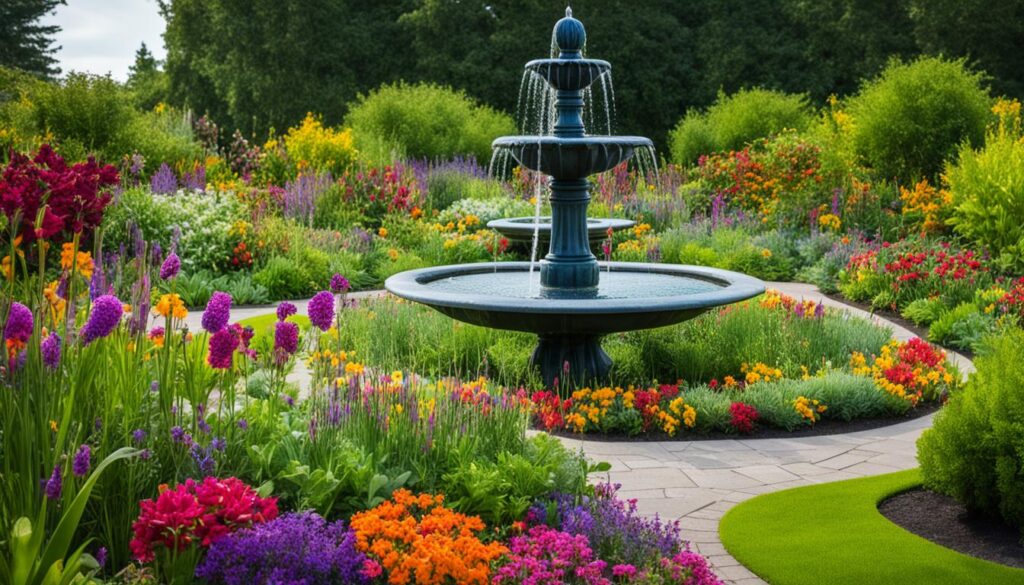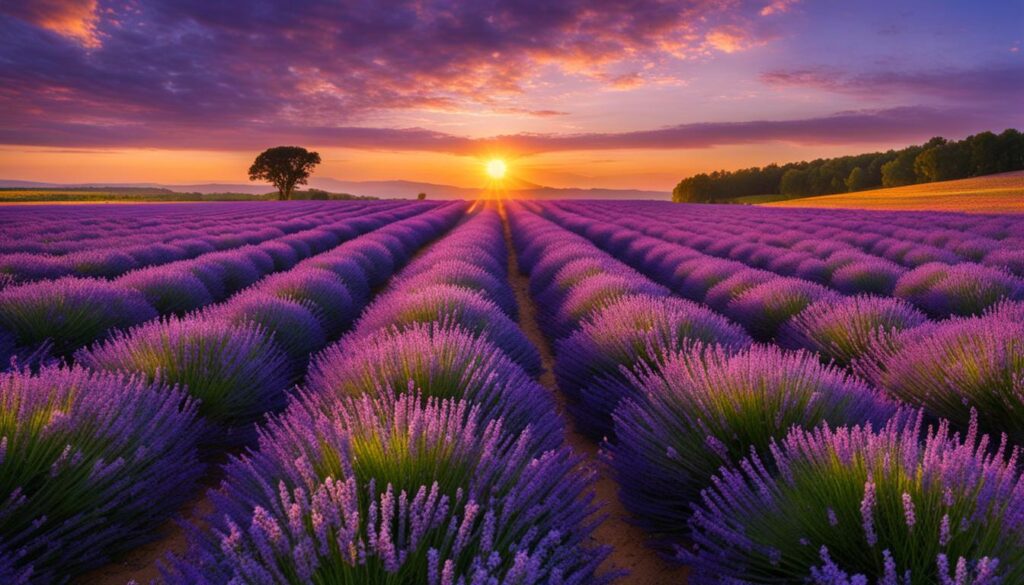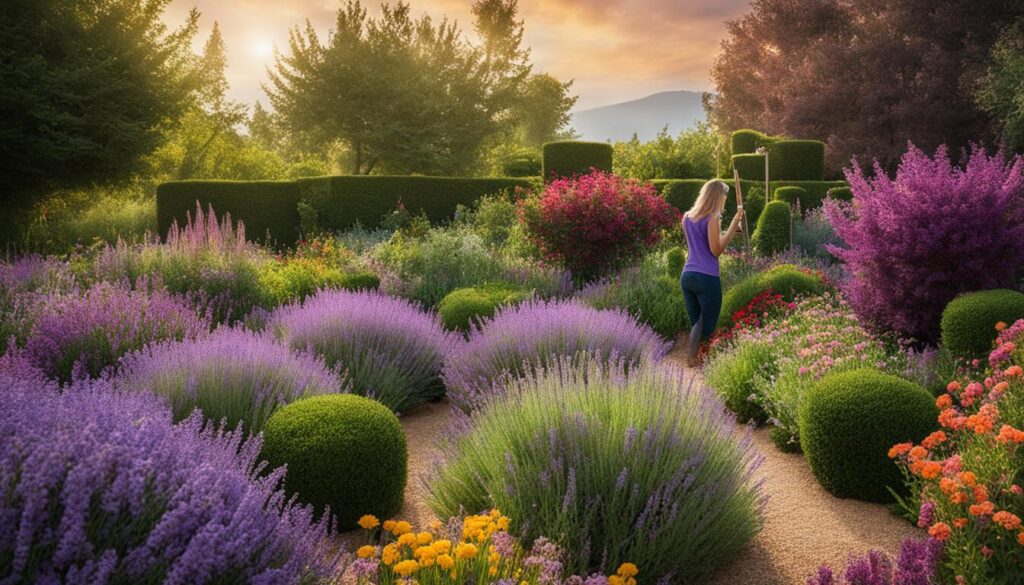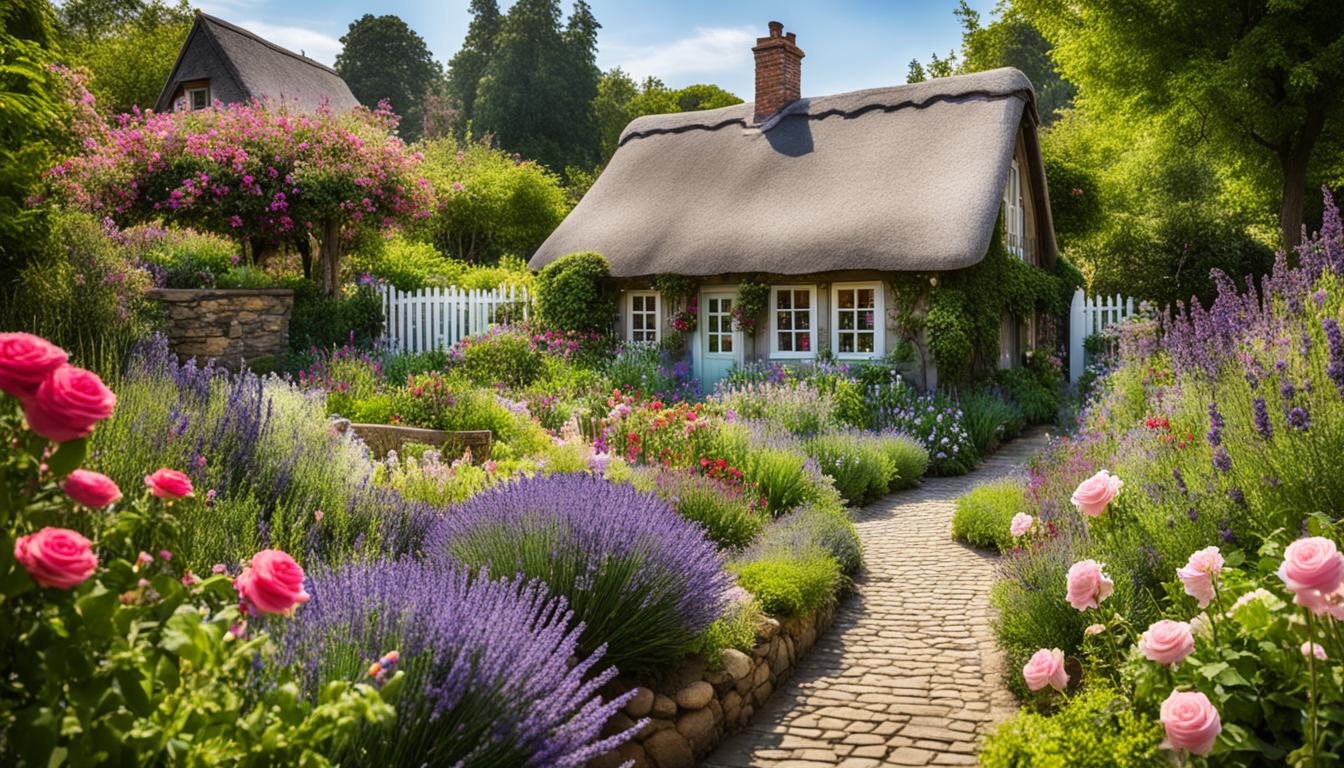Transform your garden into a Scent-sational Gardens: Fragrant Flowers and Herbs for an Aromatic Paradise with our expert tips. Spring brings a cavalcade of color and lush foliage texture in the garden, but one of the most delightful aspects is the scents that fill the air. By carefully selecting fragrant plants and considering their placement, you can create a garden that is not only visually stunning but also a sensory experience with enchanting aromas throughout the year.
Key Takeaways:
- Create a scented garden by carefully selecting fragrant flowers and herbs
- Consider the placement of the plants to maximize the aroma throughout your garden
- Choose a variety of fragrant plants with different blooming times for year-round enjoyment
- Utilize aromatic herbs for both fragrance and culinary purposes
- Seek horticultural advice to ensure a harmonious and delightful olfactory experience
Fragrant Flowers and Shrubs for a Scent-sational Garden
Fragrant flowers and shrubs play a vital role in creating a truly scent-sational garden. These lovely botanicals not only add visual appeal but also fill the air with delightful aromas. Incorporating a variety of fragrant plants can ensure a year-round olfactory delight in your garden.
Lavender is a beloved plant known for its calming fragrance. Its delicate purple flowers and soothing scent make it a must-have in any aromatic garden.
Jasmine is another popular choice with its intoxicating fragrance. The sweet scent of jasmine flowers wafting through the air can create a magical atmosphere in your garden.
If you’re looking for a shrub with a captivating scent, consider murraya. Its small white flowers release a strong, citrusy fragrance that is simply irresistible.
Cestrum is another fragrant shrub that produces clusters of tubular flowers with a sweet, spicy scent. Its flowers can vary in color, ranging from yellow and white to orange and red.
“Nature always wears the colors of the spirit.” – Ralph Waldo Emerson
Brunsfelsia, also known as yesterday, today, and tomorrow, is a unique flowering shrub. Its flowers change color as they age, starting as purple, then fading to lavender and finally white. These blooms emit a lovely scent, adding to the plant’s charm.
Daphne is a petite shrub that produces clusters of fragrant pink or white flowers. These delicate blooms release a heavenly perfume, making Daphne a popular choice for scented gardens.
For a touch of elegance, consider adding bouvardia to your garden. This flowering plant features clusters of tubular flowers with a pleasant fragrance. Bouvardia comes in various colors, including white, pink, and red.
Violet is a classic scented flower that adds a touch of charm to any garden. Its petite flowers come in a range of colors and release a delicate, sweet fragrance.
“The fragrance of flowers spreads only in the direction of the wind. But the goodness of a person spreads in all directions.” – Chanakya
If you’re seeking climbing vines with fragrant flowers, consider the sweet pea. This beautiful plant produces colorful, fragrant blossoms that are perfect for trellises and arbors.
Roses are an iconic choice for both beauty and fragrance. Different species and cultivars offer varying degrees of scent, from subtle and delicate to rich and heady. The timeless beauty of roses, combined with their captivating fragrance, makes them a staple in many gardens.
Don’t forget to incorporate plants with fragrant foliage alongside your scented flowers. These plants release their pleasant aroma when touched, adding another sensory layer to your garden.
| Plant | Fragrance |
|---|---|
| Lavender | Calming and soothing |
| Jasmine | Sweet and intoxicating |
| Murraya | Citrusy and uplifting |
| Cestrum | Sweet and spicy |
| Brunsfelsia | Varying scents; sweet, floral |
| Daphne | Heavenly and delicate |
| Bouvardia | Pleasant and elegant |
| Violet | Delicate and sweet |
| Sweet Pea | Colorful and fragrant |
| Rose | Varies, from subtle to heady |
Incorporating these fragrant flowers and shrubs into your garden will ensure a scented paradise for you to enjoy. Their beautiful blooms and captivating scents will create a sensory haven that stimulates both your visual and olfactory senses.
Creating a Fragrant Garden with Location in Mind
The location of your garden is key in fully experiencing the delightful aromas of fragrant blooms. Consider strategically planting aromatic plants near popular gathering spots such as the barbecue area or patio, allowing people to bask in the enchanting scents as they relax and socialize. Positioning these fragrant flowers and shrubs along walkways or driveways ensures that their delightful aromas envelop you as you brush against their foliage.
Gates, gateways, and entries are often overlooked areas that can greatly benefit from a touch of fragrance. Enhance these transition points by incorporating perfume-rich plants to greet you and your guests with a delightful scent. And why not add an extra dose of joy to your daily activities by arranging hanging baskets filled with sweet-scented flowers near everyday areas like the washing machine or kitchen sink?
Creating a fragrant garden with location in mind enhances your overall sensory experience, making every moment outdoors a true delight.

Maximizing Fragrance with Plant Placement
To fully maximize the fragrance in your garden, it’s important to consider the strategic placement of fragrant plants. By utilizing height variation, nose level positioning, and creative use of various structures, you can ensure that the delightful scents permeate your outdoor space. Here are some tips to help you create an aromatic haven:
1. Height Variation
Take advantage of the height variation in your garden by placing tall trees or climbing vines near windows or balconies. When these plants bloom, their fragrant blossoms will release their aroma indoors when a breeze passes through. This way, you can enjoy the delightful scents even when you’re inside.
2. Nose Level Placement
Position fragrant plants at nose level to ensure you can fully enjoy their scents every time you pass by. Hanging baskets filled with fragrant flowers are a great way to achieve this. Suspend them at a height that allows you to easily catch their intoxicating aromas as you walk by.
3. Window Placement
Placing fragrant plants near windows not only allows you to appreciate their scents but also brings the delightful aromas indoors. Whether it’s a fragrant climbing vine or a pot of scented herbs on the windowsill, these plants will infuse your home with nature’s perfume.
4. Creative Use of Structures
Make use of trellises, pergolas, and other structures to house fragrant plants. By growing climbing vines on trellises or training them along pergolas, you can create scented paths and inviting spaces. These structures also provide support for plants that may have trailing or climbing growth habits.

By incorporating these techniques, you can create a garden that not only looks beautiful but also smells heavenly. The strategic placement of fragrant plants will ensure that the scents are carried throughout your outdoor space, enhancing your enjoyment of the garden.
Aromatic Herbs for Fragrance and Flavor
Aromatic herbs are a wonderful addition to any garden, filling the air with delightful scents and adding a touch of flavor to your culinary creations. Let’s explore some of the most popular aromatic herbs that will not only enhance the fragrance of your garden but also elevate your cooking.
Lavender
 Lavender is known for its calming properties and soothing fragrance. Its purple blossoms and aromatic leaves make it a charming addition to any garden. In the kitchen, lavender adds a unique touch to desserts, teas, and even savory dishes.
Lavender is known for its calming properties and soothing fragrance. Its purple blossoms and aromatic leaves make it a charming addition to any garden. In the kitchen, lavender adds a unique touch to desserts, teas, and even savory dishes.
Mint
Mint is an energizing herb that invigorates the senses with its refreshing aroma. Whether you choose spearmint, peppermint, or a variety like chocolate mint, it can be used in drinks, salads, or as a garnish for desserts.
Rosemary
Rosemary releases its delightful scent when you brush against its needle-like leaves. This herb is perfect for herb gardens and can be used to infuse oils, flavor roasted meats, or add a fragrant twist to your homemade bread.
Thyme
With its small, aromatic leaves, thyme brings a savory and earthy fragrance to your garden. It pairs well with a variety of dishes, especially those featuring poultry, roasted vegetables, or soups.
Basil
Known for its vibrant leaves and sweet aroma, basil is a staple in many kitchens. Its aromatic foliage adds a fresh and delightful flavor to salads, sauces, pasta dishes, and more.
Scented Geraniums
Scented geraniums offer a wide range of fragrances, from lemon and rose to mint and apple. These versatile herbs can be used in cooking, teas, potpourri, or even as natural air fresheners. Their beautiful flowers and scented leaves make them a visually appealing addition to your garden.
By incorporating these aromatic herbs in your garden, you can create a fragrant oasis that delights your senses and provides a bountiful harvest of flavors for your culinary adventures.
Tips for Planning an Aromatic Garden
Planning an aromatic garden involves careful consideration of fragrance timing and selection. By strategically planning the scents in your garden, you can create a harmonious and delightful olfactory experience. Here are some tips to help you plan your aromatic garden:
1. Fragrance Planning
When planning your garden, consider the fragrance of each plant and how it will interact with others. Avoid having too many plants blooming simultaneously to prevent competing aromas. Instead, stagger the bloom times to prolong the scents and create a continuous fragrance experience.
2. Selective Blooms
Choose plants with a variety of bloom times and durations to ensure there is always a scent in your garden. Incorporate seasonal plants that bloom at different times of the year to spread the fragrance throughout the seasons. This will create an ever-changing aromatic landscape that delights the senses year-round.
3. Scents That Complement
Consider the compatibility of different scents when selecting plants for your garden. Some scents naturally complement each other and create a harmonious blend. For example, pairing lavender with rosemary creates a delightful herbal fragrance combination. Be mindful of the scents that complement each other to enhance the overall experience of your garden.
4. Horticultural Advice
Seeking horticultural advice can provide valuable insights and guidance when planning your aromatic garden. Consulting with a professional or visiting a local nursery can help you choose the right plants for your specific climate and growing conditions. They can also provide expert recommendations based on their in-depth knowledge of fragrant plants and gardening techniques.
By following these tips and incorporating fragrance planning, seasonal plants, selective blooms, scents that complement, and horticultural advice, you can design an aromatic garden that captivates the senses and creates a truly sensory delight.

The Science Behind Garden Fragrances
Fragrant plants add an extra dimension to your garden with their captivating aromas. Understanding the science behind garden fragrances can help you appreciate the different ways scents are released and enjoy the sensory experience even more.
One of the key elements of garden fragrances is essential oils. These oils can be found in the flowers and leaves of fragrant plants and are responsible for their distinct scents. When the weather warms up, these essential oils evaporate into the air, filling your garden with delightful fragrances.
Aromatic foliage, on the other hand, requires a little more effort to release its scent. By gently crushing or rubbing the leaves, you can activate the release of aromatic compounds, enhancing the overall fragrance experience in your garden.
It’s important to note that the strength of the aroma can vary depending on whether the plants are fresh or dried. Fresh aromatic plants usually offer the most robust and intense fragrances, while dried varieties may still retain some of their scent.
By understanding how essential oils, flower and leaf scents, and evaporating oils contribute to garden fragrances, you can strategically select and position plants to create a garden that delights the senses.
Benefits of Understanding the Science behind Fragrances
Understanding the science behind garden fragrances can enhance your gardening experience in several ways:
- Optimize scent release by locating fragrant plants in areas where they can be easily accessed and enjoyed.
- Create a harmonious blend of scents by pairing plants with complementary fragrances.
- Appreciate the different scent profiles of fresh and dried aromatic plants.
- Experiment with aromatic foliage and explore the diverse range of scents they can offer.
By gaining insights into the science behind garden fragrances, you can elevate your gardening endeavors and create a truly aromatic oasis.
| Types of Garden Fragrances | Description |
|---|---|
| Essential Oils | Found in flowers and leaves, these oils evaporate into the air, creating captivating aromas. |
| Aromatic Foliage | Releases scents when leaves are crushed or rubbed, adding another layer of fragrance to your garden. |
| Dried Aromas | Dried varieties of fragrant plants can still retain some of their scent, albeit less intense than fresh plants. |
| Scented Flower and Leaf Scents | Flowers and leaves emit unique scents that contribute to the overall fragrance experience in your garden. |
Fragrant Plants for Different Garden Areas
Fragrant plants offer a diverse range of options for different areas of your garden. Whether you’re looking for spring blooms, colorful shrubs, vertical accents, or ground covers, there’s a fragrant plant to suit every corner of your outdoor space.
Spring-Flowering Bulbs
Embrace the sweetness of spring with fragrant bulbs like hyacinth and narcissus. These charming flowers not only fill the air with their delightful scents but also add beauty to your garden with their vibrant blooms.
Flowering Shrubs
Add splashes of color and intoxicating fragrances to your garden with flowering shrubs like viburnum and lilac. These aromatic plants not only attract pollinators but also provide a visual delight with their stunning blossoms.
Flowering Vines
Elevate your garden’s beauty with climbing vines that bring both vertical interest and delightful scents. Honeysuckle and autumn clematis are excellent choices for infusing your outdoor space with a captivating fragrance.
Flowering Groundcovers
Create a fragrant carpet of blooms with groundcovers like lily of the valley. These low-growing plants not only offer fragrant flowers but also help suppress weeds and provide an enchanting touch to pathways and borders.
Herbaceous Perennials
Enliven your garden with herbaceous perennials that provide both fragrant flowers and foliage. Hosta and peonies are excellent choices for adding a touch of elegance and aroma to your garden beds.
Annual Flowers
Bring seasonal scents to your garden with annual flowers like sweet alyssum and stock. These plants not only fill your outdoor space with fragrance but also provide bursts of color throughout the year.
Foliage Plants
Enhance the sensory experience of your garden with foliage plants that release aromatic scents. Mint and scented geraniums are perfect choices for adding a refreshing fragrance and lush greenery to your outdoor oasis.
By incorporating a variety of fragrant plants into different areas of your garden, you can create a sensory paradise that engages not only your eyes but also your sense of smell.
Enhancing the Senses with Fragrant Gardens
Fragrant gardens are a sensory wonderland that can transform your outdoor space into a delightful retreat. The combination of vibrant blooms, lush foliage, and enchanting scents creates an immersive sensory experience that engages both the visual and olfactory senses. By incorporating aromatic plants into your garden design, you can create a symphony of fragrances that adds depth and richness to your outdoor experience.
Imagine strolling through a garden filled with the intoxicating scents of spring flowers. The gentle breeze carries the aroma of blooming roses and lavender, enveloping you in a sensory delight. The vibrant colors and sweet fragrances create a harmonious blend of color and fragrance, captivating your senses and creating a truly magical atmosphere.
Aromatic gardens not only provide visual beauty but also offer a sensorial escape. The scent experiences in a fragrant garden can evoke feelings of tranquility, joy, and nostalgia, transporting you to a place of sensory delight. Whether it’s the delicate fragrance of jasmine flowers or the invigorating aroma of herbs like rosemary and mint, each scent has its own unique power to awaken the senses.
Integrating color and fragrance in your garden design allows you to create a harmonious balance that appeals to both the eye and the nose. Consider planting fragrant flowers in a variety of hues to create a visual feast that complements the scent experiences. For example, pairing the vibrant purple blooms of lavender with the soft pink petals of roses creates a visually stunning display that is also a fragrant oasis.
Creating an Aromatic Garden Design
When designing an aromatic garden, it’s important to consider the placement of fragrant plants to maximize the sensory experience. Strategically place scented flowers and shrubs near pathways, seating areas, or outdoor living spaces where their fragrance can be enjoyed up close. This way, you can fully immerse yourself in their aromatic beauty as you relax or take a leisurely stroll through your garden.
Incorporating fragrant climbers and vines along trellises or pergolas not only adds vertical interest but also infuses the air with their captivating scents. Harness the power of height variation by planting tall aromatic trees near windows or balconies, allowing their fragrance to waft indoors and enhance your indoor-outdoor connection.
Fragrant Plants for Sensory Pleasure
A wide range of plants can be used to create sensory pleasure in your garden. Here are a few recommendations:
- Lavender: This fragrant herb is known for its soothing scent, which promotes relaxation and calmness.
- Jasmine: The delicate white flowers of jasmine release a rich, sweet fragrance that is both exotic and uplifting.
- Roses: With their diverse range of scents, roses offer a multitude of fragrant options, from sweet and fruity to spicy and musky.
- Mint: The refreshing aroma of mint adds a cool and invigorating element to any garden, perfect for sensory awakening.
“A fragrant garden is a feast for the senses, combining visual beauty with aromatic delights. It’s a space where color and fragrance come together to create a truly enchanting experience.” – Garden Enthusiast
By carefully selecting and arranging fragrant plants, you can create a garden that delights and surprises with its visual and olfactory beauty. From the first breath of spring scents to the lingering fragrance of autumn blooms, an aromatic garden invites you to surrender to the sensory pleasures of nature.
| Fragrant Plants for an Aromatic Garden | Seasonal Availability |
|---|---|
| Lavender | Spring through summer |
| Jasmine | Spring through fall |
| Roses | Spring through fall |
| Mint | Year-round |
Enhance your outdoor space with an aromatic garden design that stimulates the senses and creates a sanctuary of fragrance and beauty. Let the scents of nature transport you to a world of sensory delight, where color and fragrance intertwine to create a truly captivating and rejuvenating experience.
Conclusion
Creating a scent-sational garden with fragrant flowers and herbs allows you to transform your outdoor space into an aromatic paradise. By carefully selecting and placing fragrant plants, you can create a garden that engages all the senses. Whether it’s the subtle aroma of lavender or the heady fragrance of a blooming jasmine, your scented garden will provide a fragrant oasis for you to enjoy throughout the year.
Experience the beauty of garden aromas and create an enchanting and aromatic haven in your own backyard. The combination of visually stunning blooms and captivating scents will transport you to a fragrant oasis. Imagine strolling through your garden, surrounded by the delicate perfume of roses, the invigorating scent of mint, and the sweet fragrance of daphne. It’s a sensory experience that soothes the mind, uplifts the spirit, and delights the senses.
So, why wait? Embrace the power of garden fragrances and design your own aromatic paradise. With a carefully curated selection of scented plants and thoughtful placement, you can create a garden that not only looks beautiful but also smells divine. Escape the stresses of everyday life and immerse yourself in the soothing scents of nature. Your scented garden awaits, ready to transport you to a world of olfactory delight.
FAQ
What are some fragrant flowers and shrubs for a scent-sational garden?
Some fragrant flowers and shrubs to consider are lavender, jasmine, murraya, cestrum, brunsfelsia, Daphne, bouvardia, violet, sweet pea, and roses with varying aromatic intensities. These plants offer delightful scents that can fill your garden with fragrance.
How can I create a fragrant garden by considering the location?
To create a fragrant garden, consider planting fragrant flowers and shrubs near popular meeting places like the barbecue area or patio, where people can enjoy the delightful aromas. You can also position them along walkways and driveways to experience the scents as you brush against the foliage. Don’t forget to add fragrance to forgotten areas like gates, gateways, entries, and everyday areas like the washing machine or kitchen sink.
How can I maximize fragrance with plant placement in my garden?
To maximize fragrance, consider utilizing height variation by placing tall trees or climbing vines near windows or balconies so that their blossoms can release their aroma indoors when a breeze blows. You can also plant aromatic plants at nose level in hanging baskets, position them near windowsills, or incorporate them in trellises and pergolas to enhance their scents. Another option is to plant aromatic herbs between paving stones to release fragrance with each step.
What are some aromatic herbs that can be used in my garden for fragrance and flavor?
Some aromatic herbs that can add fragrance to your garden and be used for culinary purposes include lavender, mint, rosemary, thyme, basil, and scented geraniums. These herbs not only add delightful scents but also enhance the flavor of your dishes.
What are some tips for planning an aromatic garden?
When planning an aromatic garden, it’s important to consider fragrance timing and selection. Avoid having too many plants blooming simultaneously to prevent competing aromas. Choose a variety of seasonal plants to spread the fragrance throughout the year. Be mindful of scents that complement each other and seek horticultural advice to make the best choices for your garden.
How do fragrant plants release their scents?
Fragrant plants produce essential oils, which can be found in their flowers and leaves. When the weather warms, these oils evaporate into the air, creating captivating fragrances. Aromatic foliage often requires crushing to release its scent. Fresh aromatic plants offer the most robust aroma, but even dried varieties may retain some scent.
What are some types of fragrant plants for different areas of the garden?
There are various types of fragrant plants that can be utilized in different areas of your garden. For example, spring-flowering bulbs like hyacinth and narcissus offer sweet scents and beautiful blooms. Flowering shrubs like viburnum and lilac provide splashes of color and intoxicating fragrances. Climbing vines like honeysuckle and autumn clematis can add vertical interest and delightful scents. Groundcovers like lily of the valley and herbaceous perennials like hosta and peonies offer fragrant flowers and foliage. Annual flowers like sweet alyssum and stock bring seasonal scents, while foliage plants like mint and scented geraniums provide aromatic leaves.
How can fragrant gardens enhance the senses?
Fragrant gardens enhance the senses by combining beautiful blooms, lush foliage, and enchanting scents to create a sensory wonderland in your outdoor space. The combination of visual beauty and captivating fragrances creates a delightful experience for the eye and the nose. Designing an aromatic garden adds depth and richness to your outdoor experience, enhancing both visual and olfactory beauty.

